-

人教版高中英语必修2Cultural Relics说课稿2篇
Ⅲ. Analysis of the teaching material:The topic of this unit is cultural relics. Students are quite interested in topics about different cultures around the world. This is the second period of the whole unit. As a reading class, the passage mainly talks about the history of the amber room (how it was made, sent as a gift, lost and rebuilt).According to the new national curriculum, when teaching reading, much emphasis should be put on training the students’ reading skills.Ⅳ. Teaching objectives1. Language objectives:1) Students are required to master the key words and phrases occurred in the passage (e.g. amazing, decorate, belong, in return, less than etc.)2) Students are required to learn the attributive clause and acquire the sentence pattern.2. 1) Students are required to describe a certain thing by using the new sentence patterns.2) Students are required to master two kinds of reading skills—skimming and scanning, and learn to use them in their daily reading.3. 1) Students are required to know the history of the amber room.2) Students are required to appreciate cultural relics and understand the importance of protecting them.Ⅴ. Teaching important and difficult points1) the new words, phrases, and sentence pattern in the course of reading.2) Teaching difficult point: Help the students master two kinds of reading skills—skimmingand scanning and learn to apply them in daily use.Ⅵ. Teaching methods:Task-based method & Top-down model Ⅶ. Teaching aids: PPT, pictures, blackboard Ⅷ. Teaching procedure:

人教版高中英语必修3Astronomy the science of the stars说课稿3篇
Step 2 Pre-listeningAfter students finish their discussion, I will show a picture of Newton and ask them: Who is him? What is he famous for? Could you find out some words to describe him? Maybe students will answer that he is genius for his finding of theGravitation, making a great contribution to the progress of human being. At that time I will show another two pictures of Einstein and Hawking, letting students guess who they are and write down their idea about the Gravitation. For I have arranged them to search more information about the gravity before this class, Students have beenfamiliar with the topic and will not be afraid about this abstract conception, which is helpful for their listening.Step 3 While-listeningIn this step, students will be required to listen the material for three times. The first and listening is extensive listening and the second and third listening is intensive listening. In the first time, They are required to listen a material including Part 1 and Part 2 and choose the best summary of the listening text. After they choose the right answer, They also need work in group to explain what is wrong with the others. Then I will make a conclusion that we should pay attention to the first paragraph and last paragraph and some keys to get the main idea. By doing this, their capacity of generalization will have a great improvement.Before the second listening, I will ask students to scan the blank on the power point quickly and ask them to note down some key words .Then ask them to listen to the Part 1again and fill the first column of the chart. Maybe some students just show the ideas of these three scientists an still can’t catch their development of gravity. Therefore, I will ask them to listen to Part 2 again and fill in the rest. After finish the listening, I will give them ten minutes to discuss with their partner. I will also guidethem to improve their answers when they discuss with others.

人教版高中英语必修4A taste of English Humor说课稿3篇
Then I would ask them to think of a funny English or Chinese and tell it to partners. While telling stories, they can use expressions and some acting to help make the story funny. 5 minutes would be given to do this.Those stories they told there will be the material for their writing. Soletting them tell it at first is helpful. And they can make a difference between telling a funny story and writing it down. Generally speaking, it is difficult forstudents to write well because they don’t know what to write and how to write. Asking them to tell their own stories at first can help them come up with what to write.After their telling, I would invite someone to share his/her story with all of us and I would write it down on the blackboard.This example story would be used as a sample to illustrate the format of funny story. Different from a story from teacher or textbook, a story from students can obviously become a interesting material to draw students’ attention.Then I would ask the whole class to put this story into several parts. It might be a little bit difficult for them. So I would ask them to find out whether all the sentences are necessary. After delete some sentences, there are 6 sentences left behind. Then they can easily put them into three parts. After interaction with students, I would teach them the right terms for each part and conclude the format of funny story.This step is the key and difficult point in my lesson. So I mainly usetask-based teaching method in this part and the task for students was divided into several stages. With the separated difficult level, students can find there are usually three parts in writing. They can also learn to write without the unnecessary parts in the process of analyzing. And then I wouldn’t rush to tell them the right terms to them directly. Instead, I would ask them to name them by their own. A confused mind is better for acquiring knowledge.While-writing:Then I would give students 7 minutes to write down this story, without other requirements.With all the preparations in pre-writing, students’ difficulties were cleared. So it would be much easier for them to write down the story within 7 minutes. There are no other requirements because students’ first writing is actually a drafting. It would be revise and edit several times later. Writing, as a skill

人教版高中英语必修4Women of achievement说课稿4篇
Good morning, distinguished judges:It’s my honor to talk about my teaching ideas with you. Today my topic is Women of Achievement. My presentation consists of six parts: the analysis of teaching material and student, teaching aims, key and difficult points, teaching and studying method, teaching procedures and blackboard design.First, let’s focus on the analysis of teaching material. This lesson is from New Senior English for China Student’s Book 4 Unit 1, the reading part. The main topic of the passage is the introduction of a student of Africanwildlife. After this lesson, the students will learn more information about her studying chimps in Africa, and their reading and speaking abilities can be developed as well.The next part is the analysis of students. My students are in senior high students. They have learnt English for many years, they’ve known many words and sentences, but their speaking and reading abilities are still not very good. So I will practice their speaking and reading abilities through different exercises.According to the New Standard Curriculum and the present situation, I set the teaching aims as follows: firstly, knowledge aims. Students can grasp some new words, such as worthwhile, move off. Moreover, students can understand the content of the passage and get familiar with the topic of studying chimps in wildlife. Secondly, ability aims. Students can use reading strategies such as skimming and scanning in reading process. Thirdly, emotional aims. Students can have the awareness of protecting animals and care about animals.Based on the above analysis, the key point of this lesson is to get the main idea and the detailed information from the passage; the difficult point is to talk about the wildlife protection and use reading strategies.

人教版高中英语必修4Theme parks说课稿3篇
The oldest and the most popular park in the worldenjoy the exciting activities thereget close to the life-size cartoon characters like Mickey Mouse and Donald Duck Step 3 Pre-reading1.What do you suppose a theme park is ?2.What do you think you can see in a theme park?(1.It is a kind of amusement park which has a certain theme – that the whole park is based on. 2.buildings, castles, statues, rare animals and birds, and so on.) Step 4 Reading ----- Theme Parks –---- Fun and More Than Fun1.Predict : Read the title and the pictures on P. 34 and PredictWhat is the meaning of the title “Theme Park – Fun and more than fun”?(The title means that theme parks are fun to visit, but that they can also be educational and can offer useful information.)2.Skimming Fast read and answer:What activities can we take in a theme park?Amusement park: Bumper car Merry-go-round slide bungee jumping Free-fall rides Horror films Pirate ship Ferris wheel roller coaster3.Scanning Read again and you will find various theme parks are mentioned in the passage . Then what are they ?Theme parks: Sports theme park History theme park Culture theme park Marine or Ocean theme Park Future park Science theme park Disneyland4.Careful reading and find the main idea of each paragraph:THEME PARKS---- entertaining/ educationalPara.1 Traditional parks are places to go for relaxation and to have time away from our busy lives.Para.2 Theme parks are different They’re large and full of things to do, see and buy.Para.3 Theme parks are built around a single idea or theme. One example is a sports park.Para.4 Another kind of theme park is historical more and cultural and can be educational.Para.5 Disneylandwas the first theme park. It is based on the fantasy life and characters of Disney’s films.Para.6 Some examples of educational theme parks include sea world parks and science parks.

人教版高中英语必修4Working The Land说课稿3篇
Knowledge objectives:(1) to make Ss grasp the usage of words, expressions and sentence structures: statistics, struggle, thanks to, rid of, some patterns for persuasion, the “ing” form as subject and object;(2)to use learnt knowledge to persuade sb.Ability objectives:(1) to develop Ss’ reading skills(skimming, scanning, word guessing);(2) to improve Ss’ speaking, communicating and cooperating skills.Emotional objectives:to make Ss know the contribution of Yuan,and learn his spirit and his simple life time.Teaching important and difficult points:(1) some words, expressions and sentence structures mentioned above;(2)the content of the text;(3)training their reading and speaking skills.Teaching methods: CLT, TBLT,QT.Learning strategies: CLS, QLS, TBLS.Teaching procedures:Step 1 lead-in: (1) teacher plays a piece of recent news from CCTV about the harvest of the super hybrid rice, and ask students whether they know Yuan or not, and talk about him and his contribution.(2)Brain storm: let Ss describe Yuan in their minds including his appearance, his living condition and so on.Step 2 fast reading tasks:(1)teacher introduces Yuan and super hybrid rice(2)make Ss read the text as fast as possible with questions. Such as: what’s the general ideaof this passage? What’s Yuan’ dream? (skimming and scanning skill)Step 3 intensive reading tasks(1)let Ss read the text silently, find topic sentence of each paragraph and draw the difficult sentences and the knowledge what they don’t understand.(words guessing)(2)teacher and Ss talk about the important words, expressions and sentences together, and ask Ss to retell the content of the text.(summarizing and paraphrasing)(3)teacher summarize this part.(4) read again following the courseware.

人教版高中英语必修5First aid说课稿6篇
In this class, I have 3 teaching aims, that is, knowledge aims, ability aims and emotion aims.1) Knowledge-Teach students new words and expressions, such as temporary, bleed,sprain choke, first aid, fall ill and so on.-Enable students to have a better understanding for some basic knowledge of first aid.2) Ability-Train students’ speaking, reading and writing abilities by different teaching activities, such as skimming, comprehending, team work, role play, retelling and writing.-Develop students’ reading strategy on how to move general idea to specific information.3) Emotion-Promote students’ awareness of giving first aid.- Cultivate students’ creativities.Then let’s come to my teaching methods and activities.III. Teaching methods and activities:To achieve different teaching aims, various kinds of teaching methods and activities will be adopted throughout this period, such as TBL (task-based learning), skimming, team work, brainstorm and others, which can offer students opportunities to fulfill tasks in which they can use language to achieve a specific outcome.IV. Teaching aids:Computer and blackboardV. Teaching important points:1) Make students have a clear mind for the structure of the text.2) Help students understand the theme of the text.VI. Teaching difficulties:1) So many new words may affect students’ understanding.2) How to get students to know about the functions of the skin and thecauses, characteristics and treatments for different degree burns,and the knowledge about giving first aid. VII. Blackboard design:

人教版高中英语必修5Life in the Future说课稿5篇
Good afternoon, everyone. It’s my great pleasure to be here sharing my lesson with you. The content of my lesson is Senior English for China Book5 Unit 3 Life in the Future. I’ll be ready to begin this lesson from six parts: Analysis of the teaching material, Analysis of the students, Teaching aims and important and difficult points, Teaching methods and aids, Teaching procedures, and Blackboard design. First, let me talk about the teaching material.Part 1 Analysis of the Teaching Material:This unit is about what human beings’ life will be like in about one thousand years. By studying of this unit, we’ll Enable the students to know the changes in humans’ life and some new inventions bringing about the change and develop the interest in science. This lesson plays an important part in the English teaching in this unit. This is an important lesson in Book Five. From this lesson, it starts asking the Ss to grasp contents of each passage. Therefore, this lesson is in the important position of the teaching material. If the Ss can learn it well, it will be helpful to make the Ss learn the rest of this unit.Part 2 Analysis of the SsAs Senior2 Ss, they are at different levels of English fluency, some of them have lost interest in English. So during the lesson, I arrange a variety of activities to let all of them join in to attract their interest and let them be confident and taste the joy of success.

人教版高中英语必修5The United Kingdom说课稿4篇
Teaching Aims:Knowledge 1. Get the students to learn the useful new words and expressions in this section. Aims:2. Let the students learn about how the UK was formed and the four groups of invaders.1. Develop students’ reading ability and let them learn different Ability reading skills. Aims:2. Enable students to learn to talk about the United Kingdom and the Union Jack Emotional 1. Let students know more about the UK2. Develop students’ sense of cooperative learning Aims:Teaching Important Points:1. Let the students learn about the countries of the United Kingdom and the Union Jack2. Get the students to read the passage and know about how the UK was formed and the four groups of invaders.3. Have the students learn different reading skills.Teaching Difficult Ponts:1. Develop students’ reading ability.2. Enable students to talk about the United Kingdom and the Union Jack.3. Let students learn how the UK was formed geographically and historically.Teaching Methods:Showing pictures, asking, exercising, listening, reading etc.Teaching Aids:A computer,a projector and a blackboard.Teaching Procedures: 1) Show a map of the world, ask students the following questions:Where is the UK?What’s the full name of the UK?2) Ask the students work in pairs to do the quiz on Page 9.Do you want to test how many things you know about the United Kingdom? Let’s have a small test.Using the map on P9, students answer the following questions:?How many countries does the UK consist of? What are they??England is divided into three main areas. Do you know what they are? 1) Scanning (10Minutes )Let the students hold the questions asked in pre-reading and read the passagequickly and then let them do the following exercise.Join lines to the right answer.
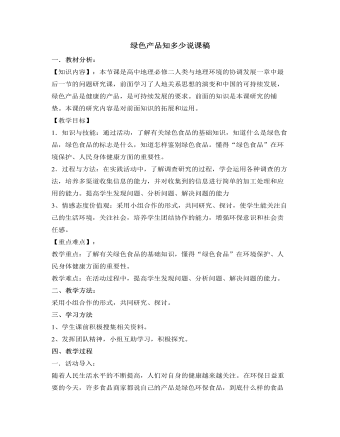
人教版高中地理必修2绿色产品知多少说课稿
各小组派代表汇报。4、教师提出问题组织学生讨论:⑴要想了解更多的绿色食品,了解绿色食品的销售情况,我们应该怎么做?⑵要想了解广大消费者对绿色食品的态度,食用绿色食品的意义,是否懂得辨认绿色食品,以及什么样的人群对此知识最缺乏等,我们应该怎么做?组织学生汇报交流。5、做个“绿色食品”广告设计师。为你喜欢的绿色食品设计广告语,每组推荐一个。6、让学生了解绿色食品认证程序。7、绿色食品打“假”队员在行动。8、向学生介绍生态绿色食品基地。三、活动总结:通过研究、探讨,了解学生对绿色食品的态度。提问:民以食为天,吃,是一个大问题,如果你的爸爸妈妈让你到超市买牛奶、方便面等,你会选择什么样的食品?为什么?希望通过今天的学习,同学们能够做到绿色消费,也希望你们向自己的家人、向周围的了解学生对“无公害食品”、“有机食品”与“绿色食品”的认识。

人教版高中地理必修2煤城焦作出路何在说课稿
分析过焦作市的地理概况和产业优势后,就需要针对由于资源枯竭所带来的问题提出合理化的建议。既然是谈经济转型,就应该将话题的范围明确在这一领域内。通过材料3的相关内容,我们了解到焦作市需要在产业结构调整、培育新的优势产业、增强综合竞争力等三个整改方针上下功夫。因而引导学生针对优势与不足提出建议,以三个整改方针为基准,衡量建议的可行性是锻炼学生解决此类问题的有效途径。在此我将教会学生的是解决问题方法而非案例的内容,正所谓“授之以鱼,不如授之以渔”。接下来针对学生的建议和教材资料分析所罗列的10点整改思路,由学生自由发言提出看法,通过教师的指导和学生的讨论,进而确定经济转型建议的具体方案。最后注意将建议与产业优势相对照,看建议是否都是围绕着产业优势而提出的,这样做会加深学生的印象,通过建议和优势的对应关系,将不难找出此类问题的解题思路。
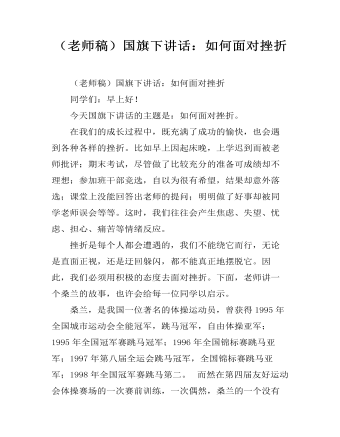
(老师稿)国旗下讲话:为理想而奋斗
有同学要做一个科学家,发明各种各样的机器,减轻人们的劳动;有的要做一名关心热爱学生的好老师,为祖国的后代默默奉献……是呀,同学们的理想很多,但理想也绝不是转眼之间便可以实现的,而奋斗则是实现理想的桥梁,只有从基本的地方做起,循序渐进地朝着目标行进,才会慢慢地接近它、达到它。同学们,你们都知道电灯是谁发明的吗?对了,是美国伟大的发明家爱迪生。在他光辉的一生中,他发明了上千种与我们生活息息相关的东西,比如照相机、投影仪……那么,你们知道吗,又是什么成就他伟大的事业呢?是奋斗,是为自己的理想奋斗的精神。爱迪生在发明电灯时,要寻找一种即能节省电又能长时间使用的金属作灯丝,为了能够找到这样的一种金属,他一边干活挣钱,一继续不停地进行试验。成千上万次的失败,没有让爱迪生灰心丧气,反而激发了他坚强的斗志。最后,他终于成功了,找到金属钨作灯丝,也就是我们现在常用的电灯。
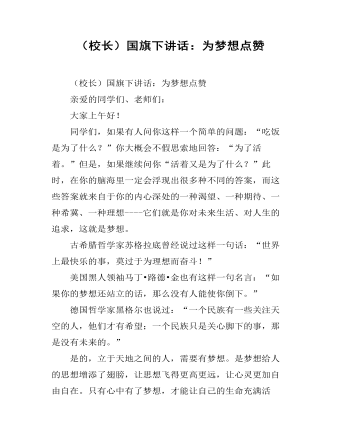
(校长)国旗下讲话:为梦想点赞
同学们,如果有人问你这样一个简单的问题:“吃饭是为了什么?”你大概会不假思索地回答:“为了活着。”但是,如果继续问你“活着又是为了什么?”此时,在你的脑海里一定会浮现出很多种不同的答案,而这些答案就来自于你的内心深处的一种渴望、一种期待、一种希冀、一种理想----它们就是你对未来生活、对人生的追求,这就是梦想。古希腊哲学家苏格拉底曾经说过这样一句话:“世界上最快乐的事,莫过于为理想而奋斗!”美国黑人领袖马丁?路德?金也有这样一句名言:“如果你的梦想还站立的话,那么没有人能使你倒下。”德国哲学家黑格尔也说过:“一个民族有一些关注天空的人,他们才有希望;一个民族只是关心脚下的事,那是没有未来的。”
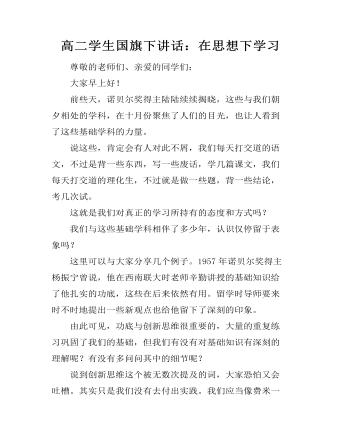
高二学生国旗下讲话:在思想下学习
尊敬的老师们、亲爱的同学们:大家早上好!前些天,诺贝尔奖得主陆陆续续揭晓,这些与我们朝夕相处的学科,在十月份聚焦了人们的目光,也让人看到了这些基础学科的力量。说这些,肯定会有人对此不屑,我们每天打交道的语文,不过是背一些东西,写一些废话,学几篇课文,我们每天打交道的理化生,不过就是做一些题,背一些结论,考几次试。这就是我们对真正的学习所持有的态度和方式吗?我们与这些基础学科相伴了多少年,认识仅停留于表象吗?这里可以与大家分享几个例子。1957年诺贝尔奖得主杨振宁曾说,他在西南联大时老师辛勤讲授的基础知识给了他扎实的功底,这些在后来依然有用。留学时导师要来时不时地提出一些新观点也给他留下了深刻的印象。
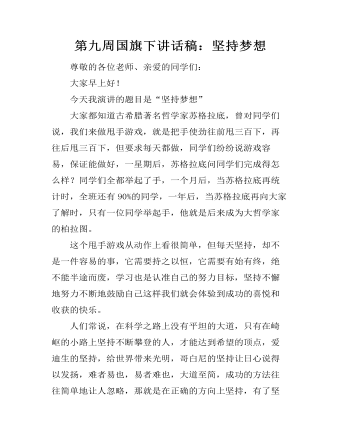
第九周国旗下讲话稿:坚持梦想
尊敬的各位老师、亲爱的同学们:大家早上好!今天我演讲的题目是“坚持梦想”大家都知道古希腊著名哲学家苏格拉底,曾对同学们说,我们来做甩手游戏,就是把手使劲往前甩三百下,再往后甩三百下,但要求每天都做,同学们纷纷说游戏容易,保证能做好,一星期后,苏格拉底问同学们完成得怎么样?同学们全都举起了手,一个月后,当苏格拉底再统计时,全班还有90%的同学,一年后,当苏格拉底再向大家了解时,只有一位同学举起手,他就是后来成为大哲学家的柏拉图。这个甩手游戏从动作上看很简单,但每天坚持,却不是一件容易的事,它需要持之以恒,它需要有始有终,绝不能半途而废,学习也是认准自己的努力目标,坚持不懈地努力不断地鼓励自己这样我们就会体验到成功的喜悦和收获的快乐。
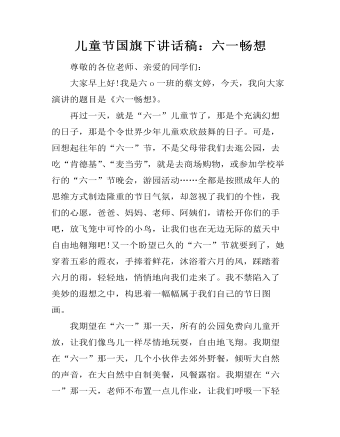
儿童节国旗下讲话稿:六一畅想
尊敬的各位老师、亲爱的同学们:大家早上好!我是六o一班的蔡文婷,今天,我向大家演讲的题目是《六一畅想》。再过一天,就是“六一”儿童节了,那是个充满幻想的日子,那是个令世界少年儿童欢欣鼓舞的日子。可是,回想起往年的“六一”节,不是父母带我们去逛公园,去吃“肯德基”、“麦当劳”,就是去商场购物,或参加学校举行的“六一”节晚会,游园活动……全都是按照成年人的思维方式制造隆重的节日气氛,却忽视了我们的个性,我们的心愿,爸爸、妈妈、老师、阿姨们,请松开你们的手吧,放飞笼中可怜的小鸟,让我们也在无边无际的蓝天中自由地翱翔吧!又一个盼望已久的“六一”节就要到了,她穿着五彩的霞衣,手捧着鲜花,沐浴着六月的风,踩踏着六月的雨,轻轻地,悄悄地向我们走来了。我不禁陷入了美妙的遐想之中,构思着一幅幅属于我们自己的节日图画。我期望在“六一”那一天,所有的公园免费向儿童开放,让我们像鸟儿一样尽情地玩耍,自由地飞翔。我期望在“六一”那一天,几个小伙伴去郊外野餐,倾听大自然的声音,在大自然中自制美餐,风餐露宿。我期望在“六一”那一天,老师不布置一点儿作业,让我们呼吸一下轻松的空气,家长不再给我们补课,让我们做一回自己的主人。
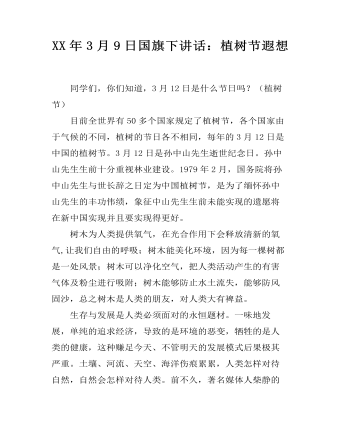
XX年3月9日国旗下讲话:植树节遐想
同学们,你们知道,3月12日是什么节日吗?(植树节)目前全世界有50多个国家规定了植树节,各个国家由于气候的不同,植树的节日各不相同,每年的3月12日是中国的植树节。3月12日是孙中山先生逝世纪念日。孙中山先生生前十分重视林业建设。1979年2月,国务院将孙中山先生与世长辞之日定为中国植树节,是为了缅怀孙中山先生的丰功伟绩,象征中山先生生前未能实现的遗愿将在新中国实现并且要实现得更好。树木为人类提供氧气,在光合作用下会释放清新的氧气,让我们自由的呼吸;树木能美化环境,因为每一棵树都是一处风景;树木可以净化空气,把人类活动产生的有害气体及粉尘进行吸附;树木能够防止水土流失,能够防风固沙,总之树木是人类的朋友,对人类大有裨益。生存与发展是人类必须面对的永恒题材。一味地发展,单纯的追求经济,导致的是环境的恶变,牺牲的是人类的健康,这种赚足今天、不管明天的发展模式后果极其严重。土壤、河流、天空、海洋伤痕累累,人类怎样对待自然,自然会怎样对待人类。
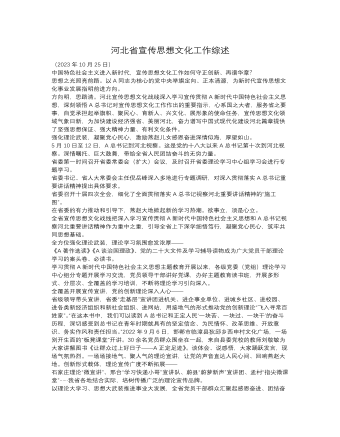
河北省宣传思想文化工作综述
我省话剧《塞罕长歌》、舞蹈《人民英雄纪念碑》分别荣获“文华大奖”和群星奖;中宣部公布第十六届精神文明建设“五个一工程”获奖名单,电影《我和我的父辈》、图书“足迹”系列荣获“特别奖”,话剧《青松岭的好日子》、歌曲《春风十万里》荣获“优秀作品奖”。放眼燕赵大地,文化旅游深度融合,文化惠民工程深入实施,文化产业快速发展,新时代文化事业生机盎然。今年中秋国庆假期,全省迎来旅游消费高峰,接待游客人数、旅游收入分别达到2019年的148.8%和144.2%,其中京津游客811.89万人次,“这么近,那么美,周末到河北”成为新时尚。“精彩!过瘾!”10月20日晚,“点亮北方戏窝子”2023年东西南北中五路丝弦优秀剧目展演在石家庄拉开帷幕,32个丝弦院团轮番献艺,“北方戏窝子”焕发新风采。日前,第十九届中国吴桥国际杂技节在石家庄开场,自创办以来,来自60多个国家和地区的600多个节目、30000多名中外嘉宾和杂技艺术家相聚河北,这场“杂技的盛会”为中外文明交流互鉴注入新力量。
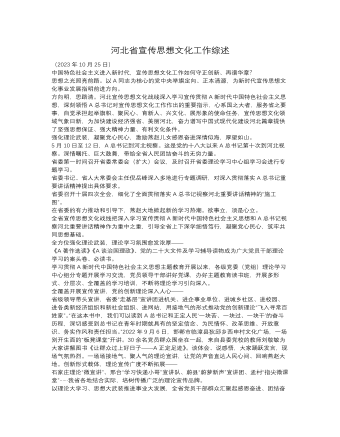
河北省宣传思想文化工作综述
“开船喽!”去年6月24日,京杭大运河京冀段62公里实现互联互通。2022年6月1日起,《河北省大运河文化遗产保护利用条例》正式施行。我省积极保护好、传承好、利用好大运河,大运河沿岸生态环境、文旅融合等持续取得新进展。文艺是时代前进的号角。我省话剧《塞罕长歌》、舞蹈《人民英雄纪念碑》分别荣获“文华大奖”和群星奖;中宣部公布第十六届精神文明建设“五个一工程”获奖名单,电影《我和我的父辈》、图书“足迹”系列荣获“特别奖”,话剧《青松岭的好日子》、歌曲《春风十万里》荣获“优秀作品奖”。放眼燕赵大地,文化旅游深度融合,文化惠民工程深入实施,文化产业快速发展,新时代文化事业生机盎然。今年中秋国庆假期,全省迎来旅游消费高峰,接待游客人数、旅游收入分别达到2019年的148.8%和144.2%,其中京津游客811.89万人次,“这么近,那么美,周末到河北”成为新时尚。
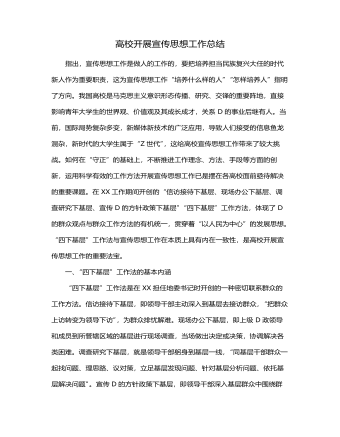
高校开展宣传思想工作总结
“我们D最大的政治优势是密切联系群众,执政后的最大危险是脱离群众。”要做到密切联系群众就要善于为群众服务,为群众解决生活中的实际困难,办好事实事。“四下基层”工作法正是按照把民情了解好、政策宣传好、群众服务好、矛盾化解好、工作落实好的目标要求,帮助群众解决生产生活中的具体问题,成为D联系群众、服务群众的重要渠道。进入新时代、互联网时代、后疫情时代,高校师生的民主意识、参与意识更加强烈,更喜欢用鲜明而直接的方式表达诉求、参与互动。针对这些新变化、新特点,高校宣传思想工作要坚持以人民为中心,站稳人民立场,秉持走好群众路线的态度,坚持“四下基层”工作法,深入基层、深入一线,访民意、察民情,及时了解师生所想所愿,着力在抓住重点难点、解决薄弱点上下功夫,开展面对面宣讲、心贴心宣传、点对点传播,通过事实与道理共同阐释的方式,向广大师生讲清楚“怎么看”“怎么办”,引导师生在纷繁复杂的社会思潮中坚定立场、明辨是非。同时,新时代高校宣传思想工作坚持以立德树人为根本,通过“四下基层”,到师生群众中间开展形式多样、特色鲜明的社会主义核心价值观宣传教育活动以及丰富多彩的文化活动,为基层师生输送接地气、有温度、感染力强的宣传文化作品,满足师生多层次和多样化的精神文化需求,可以有效增进师生的获得感和幸福感,引导师生将社会主义核心价值观转化为情感认同和行为习惯。




